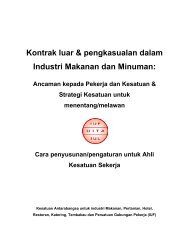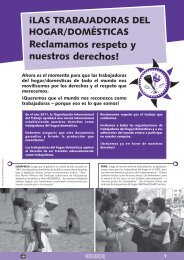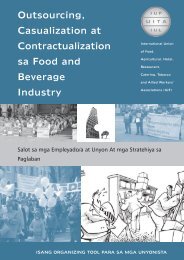Health, Safety and Environment - International Labour Organization
Health, Safety and Environment - International Labour Organization
Health, Safety and Environment - International Labour Organization
You also want an ePaper? Increase the reach of your titles
YUMPU automatically turns print PDFs into web optimized ePapers that Google loves.
Manual 5:PESTICIDES AND HEALTH,SAFETY & THE ENVIRONMENTTypes of personal protective equipment for workers onfarms <strong>and</strong> plantationsGloves: Protective, unlined rubber or neoprene gloves, which should be at least 0.4mmthick whilst retaining flexibility in all weather, should always be worn when h<strong>and</strong>lingpesticides. They should protect the whole h<strong>and</strong> <strong>and</strong> wrist – being not less than 300millimetres in length measured from the tip of the second finger to the edge of the cuff.Sleeves of coveralls should be worn under the gloves at all times. Gloves should be designedfor use with pesticides (General industrial gloves which often have a cloth cuff are notsuitable as they will absorb pesticide). Some pesticides like methyl bromide penetraterubber gloves, <strong>and</strong> also natural rubber gloves may not prevent contamination from solventslike xylene.Torn or damaged gloves should not be worn <strong>and</strong> should be replaced immediately. The glovesshould be washed daily after work with water <strong>and</strong> detergent, rinsed <strong>and</strong> dried. Regularreplacement is also important.Apron: A protective rubber/neoprene apron covering the front <strong>and</strong> sides of the body fromimmediately below the shoulders to at least 70 millimetres below the tops of any boots thatare being worn (it should extend to at least below the knees).Coverall: A protective garment, or combination of garments (offering no less protection thana single garment), close fitting at the neck <strong>and</strong> wrist <strong>and</strong> which: covers the whole body <strong>and</strong> all clothing other than that which is covered by a good,face-shield, respiratory protective equipment, footwear <strong>and</strong> gloves, <strong>and</strong> which minimisesheat stress to the operator when worn when required to be worn in connection with the use of a pesticide in the form of agranule, dust or powder, has all its external pockets covered <strong>and</strong> has its sleeves over thetops of gloves being worn is white or of a colour which produces a clearly noticeable contrast if contaminated withpesticide is regularly washed to avoid contamination with pesticideBoots: Protective (gum or wellington) boots made of rubber or neoprene extending to at leastimmediately below the knees. Coveralls should be worn over the top of boot. Leather orcanvas boots are NOT suitable as they readily absorb pesticideFace shield: A transparent shield covering the whole of the forehead <strong>and</strong> face designed soas to protect the forehead <strong>and</strong> face from being splashed. These are better than goggleswhich only protect the eyes. (If goggles are used, the eye lenses must be chemicallyresistant <strong>and</strong> the straps plastic or rubber, NOT cloth)Head gear: A hood or waterproof, wide brimmed hat, or other covering to the head sodesigned as to protect the forehead, neck, <strong>and</strong> back <strong>and</strong> sides of the head fromcontamination by pesticide in the circumstances in which is being usedRespiratory protective equipment (RPE): Respirators, breathing apparatus, cartridges(filters), <strong>and</strong> masks should be of a type approved by, or conforming to a st<strong>and</strong>ard approvedby, the pesticide registration or health <strong>and</strong> safety authority in a country. RPE isrecommended for use with more hazardous pesticides (see the label or data sheet). Thechemical cartridges should be the one approved for a particular pesticide(s) <strong>and</strong> they shouldbe changed regularly when odours are detected through them, when breathing is restrictedor according to manufacturer’s instructions or the law – whichever comes first.253 <strong>Health</strong>, <strong>Safety</strong> <strong>and</strong> <strong>Environment</strong>A Series of Trade Union EducationManuals for Agricultural Workers














